Type Confectionery | ||
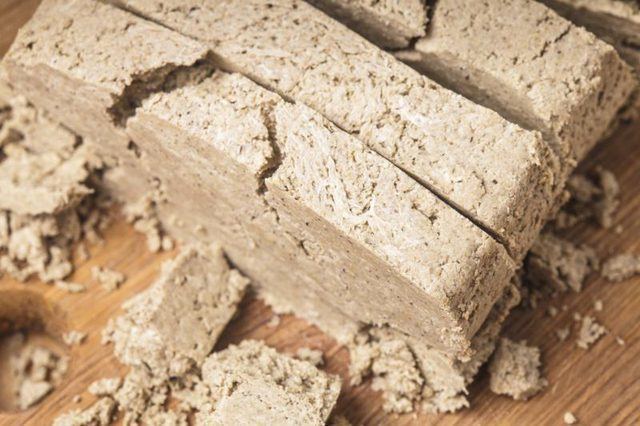 | ||
Alternative names halawa, haleweh, halava, helava, helva, halwa, aluva, chalva, alva Region or state Afghanistan, Armenia, Azerbaijan, Bosnia, Bulgaria, Croatia, Cyprus, Egypt, Georgia, Greece, India, Iran, Iraq, Israel, Jordan, Lithuania, Lebanon, Pakistan, Palestine, Poland, Russia, Serbia, Syria, Turkey, Kenya, and Ukraine Similar | ||
Gajar ka halwa carrot halva recipe
Halva (halawa, alva, haleweh, halava, helava, helva, halwa, halua, aluva, chalva) is any of various dense, sweet confections served across the Middle East, South Asia, Central Asia, West Asia, North Africa, the Horn of Africa, the Balkans, Central Europe, Eastern Europe, Malta and the Jewish diaspora.
Contents
- Gajar ka halwa carrot halva recipe
- Sweet halva corn flour cook with faiza
- Etymology
- Types
- Flour based
- Semolina suji
- Cornstarch
- Rice flour
- Nut butterbased
- Sesame
- Sunflower
- Floss halva
- Cultural use
- Albania
- Argentina
- Bahrain
- Bangladesh
- Bosnia and Herzegovina
- Brazil
- Bulgaria
- Croatia
- Egypt
- Greece and Cyprus
- India
- Iran
- Israel
- Lebanon Syria Iraq Jordan and Palestine
- Libya and Tunisia
- Lithuania Latvia Estonia
- Republic of Macedonia
- Malta
- Myanmar
- Oman
- Pakistan
- Poland
- Romania and Moldova
- Russia and Belarus
- Serbia
- Slovenia
- Somalia
- Sri Lanka
- Tajikistan and Uzbekistan
- Turkey
- Ukraine
- United States
- References
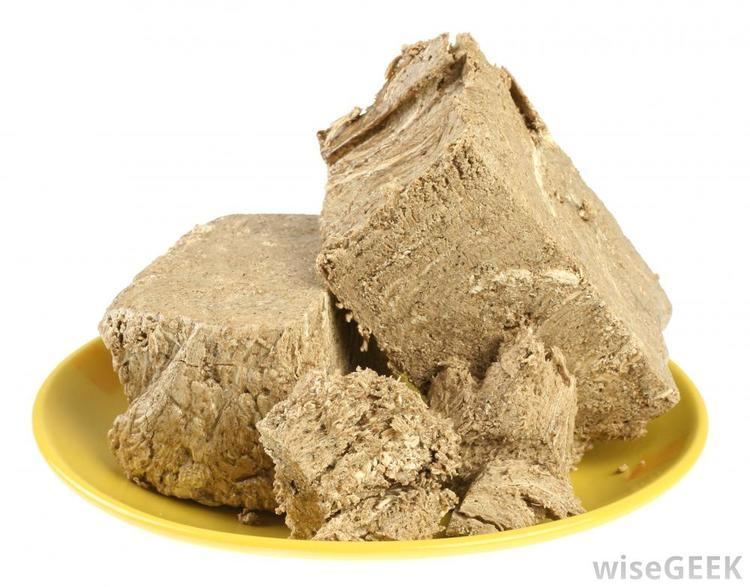
In global, popular usage it means "desserts" or "sweet", and describes two types of desserts:
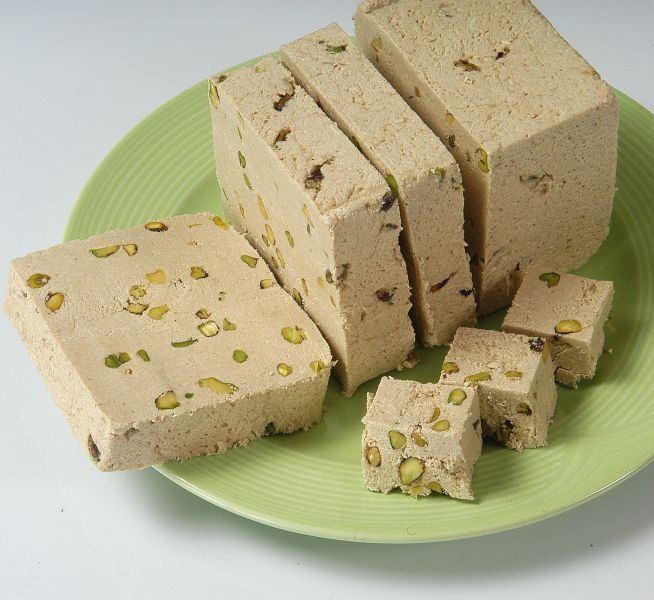
Halva may also be based on various other ingredients, including sunflower seeds, nut varieties, beans, lentils, and vegetables such as carrots, pumpkins, yams and squashes.

Halva can be kept at room temperature with little risk of spoilage. However, during hot summer months, it is better kept refrigerated, as it can turn runny after several days.
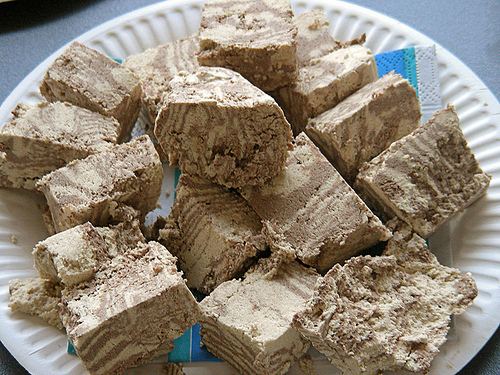
Sweet halva corn flour cook with faiza
Etymology
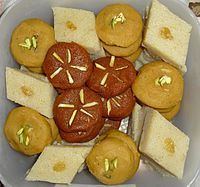
The word halva entered the English language between 1840 and 1850 from the Yiddish halva, which came from the Turkish helva, itself ultimately derived from the Arabic: حلوى ḥalwá, a sweet confection. The Arabic root حلو ḥelw means "sweet".
Types

Most types of halva are relatively dense confections sweetened with sugar or honey. Their textures, however, vary. For example, semolina-based halva is gelatinous and translucent, while Sesame-based halva is drier and more crumbly.
Flour-based
This type of halva is made by frying flour (such as semolina) in oil, mixing it into a roux, and then cooking it with a sugary syrup. This variety is popular in India, Greece, Armenia, Iran, Azerbaijan, Turkey, Somalia, Pakistan, and Afghanistan.
Semolina (suji)
This variety of halva is produced and served in India, Afghanistan, Nepal, Bangladesh, Pakistan, and surrounding countries (different versions of it are also found in Albania, Azerbaijan, Bulgaria, Cyprus, Greece, Montenegro, Macedonia and Turkey). It is usually made with wheat semolina, sugar or honey, and butter or vegetable oil. Raisins, dates, other dried fruits, or nuts such as almonds or walnuts, are often added to semolina halva. The halva is very sweet, with a gelatinous texture similar to polenta; the added butter gives it a rich mouthfeel. The standard proportions of semolina halva are: one part fat (a vegetable oil or butter), two parts semolina, two parts sweetening agent (e.g. sugar or honey), and four parts water. The semolina is sautéed in the fat, while a syrup is made from the sweetener and water. Then the two are mixed carefully while hot, and any extra ingredients are added. At this point, the halva is off-white to light beige, and rather soft. Depending on recipe and taste, it can be cooked a bit further, which makes it darker and firmer, or left to set as is.
In India, halva is prepared in different forms. The recipes use flour, melted butter or ghee, sugar and optionally acacia gum (gum arabic, also known as Dinka or Goondh or Katira Goond or Gond or Kamarka). It comes in various colors like orange, brown, green and white; in a translucent appearance studded with raisins, cashew nuts, pistachios, almonds, etc. Technically- the term halva is used in native recipes throughout India, and though semolina halva is considered to be a quintessential "Northern" confection, it is also quite popular in South India. A prominent South Indian version of halva (or alvaa in Tamil) is from Tirunelveli, a city in the state of Tamil Nadu. Another semolina preparation widely enjoyed throughout South India called kesari or kesari-bath originates from the state of Karnataka.
Alternative vegetable-based halva recipes popular in India and Pakistan use beetroots, potatoes, yams, and most commonly carrots (for gajar halwa), mung beans (for moong dal halwa), or bottle gourds (for doodi halwa) instead of semolina. Prepared with condensed milk and ghee, without semolina to bind it together, the end result has a moist, yet flaky, texture when freshly prepared. Other examples include the famous Agra Petha- easily available at Taj Mahal, Agra.
Cornstarch
Cornstarch halva is popular in Greece, and has many variations. The Farsala recipe is the most well known. It is quite sweet, with caramel-like syrup.
Rice flour
This rice flour and coconut milk halva is common fare on the streets of Zanzibar.
Nut butter–based
This type of halva is made by grinding oily seeds, such as sesame or sunflower seeds, to a paste, and then mixing with hot sugar syrup cooked to hard-crack stage. This type is popular in eastern Arab nations, the Mediterranean, and in Balkan regions and countries. Some include Bosnia and Herzegovina, Croatia, Romania, Serbia, Macedonia, Montenegro, Bulgaria, Russia, Greece and Cyprus, Egypt, Iraq, Iran, the Levant, Macedonia, Albania, Central Asia, southern India, the Caucasus region, and Turkey. It is also popular in Algeria and on the central Mediterranean islands of Malta.
Sesame
Sesame halva is popular in the Balkans, Poland, Middle East, and other areas surrounding the Mediterranean Sea. The primary ingredients in this confection are sesame butter or paste (tahini), and sugar, glucose or honey. Soapwort (called ‘erq al halaweh in Arabic; çöven in Turkish), egg white, or marshmallow root are added in some recipes to stabilize the oils in the mixture or create a distinctive texture for the resulting confection. A version of sesame halva, called sesame crisp candy (芝麻酥糖) in China uses ground sesame and sugar, cooked to the hard ball stage because it is made crispier than other halvas.
Other ingredients and flavorings, such as pistachio nuts, cocoa powder, orange juice, vanilla, or chocolate are often added to the basic tahini and sugar base.
Sunflower
Sunflower halva is popular in countries in Eastern Europe, including Belarus, Bulgaria, Romania, Moldova, Latvia, Lithuania, Estonia, Russia, and Ukraine as well as other former U.S.S.R countries. It is made of sunflower seeds instead of sesame.
Floss halva
Pişmaniye (Turkish) or floss halva is a traditional sweet, prepared in Kocaeli, Turkey, made by flossing thin strands of halva into a light confection. Made primarily of wheat flour and sugar, the strands are continuously wrapped into a ball shape and then compressed. The result is a halva with a light consistency, similar to cotton candy. Floss halva can be found in regular and pistachio flavors, and there are brands with halal or kosher certifications.
A similar pistachio-based version of floss halva is popular in North India. It tends to be slightly denser and is often referred to as patisa or sohan papdi. In Chinese cuisine, a floss-like candy similar to pismaniye or pashmak halva, known as dragon beard candy, is eaten as a snack or dessert.
A raw version of halva also has become popular among proponents of raw food diets. In this version, a mixture of raw sesame tahini, raw almonds, raw agave nectar and salt are blended together and frozen to firm.
Cultural use
Halva is the most common modern English spelling and the transliteration from most Balkan languages. Other transliterations include ħelwa (Maltese), xalwo (Somali), halvah (Hebrew), halwa or halwi (Arabic), helva (Turkish), chałwa (Polish), and halva (Hindustani).
The Hebrew-derived spelling, halvah (Hebrew: חלבה), may at times be used to refer specifically to the kosher variety.
The word halawa (حلاوة) in Arabic means 'sweetness', while the word halwa (حلوى) means sweets or candy. The word halva comes from the Arabic word halwa; the root word is hilwa meaning sweet.
Albania
Halva, hallvë in Albanian, is usually eaten as a dessert-based meal, that is, with no entrees or appetizers consumed prior. The majority of halva in Albania is flour halva, although home-cooked semolina halva and shop-produced sesame halva are also consumed. Wheat flour is usually used, although corn flour halva is also common.
Argentina
Halva is available in Argentina, especially from confectioners of Syrian-Lebanese or Armenian origin. In the 1940s, a halva substitute named Mantecol made with peanut butter was introduced by Río Segundo's Georgalos, a Greek immigrant family firm. It became a popular product; in 2001, the brand was sold to global firm Cadbury Schweppes, which altered the recipe. Georgalos now manufactures the original product under the name Nucrem. Both versions are available in candy stores and supermarkets. It is also popular by the Indians and Indo-Caribbeans who brought their form of halva.
Bahrain
In Bahrain, the most popular form of halva is a jelly-styled sweet also known as halwa Bahraini in neighboring countries. And it is not like the halva that in most countries is based on sesame paste and in Kuwait called rahash.
Bangladesh
Various kinds of halwa (Bengali: হালুয়া) are prepared across Bangladesh and West Bengal. Some of the most common types of halua include semolina (সুজির হালুয়া shujir halua), carrot (গাজরের হালুয়া gajorer halua), chickpea (বুটের হালুয়া buṭer halua), flour (নেশেস্তার হালুয়া neshestar halua), almond (বাদামের হালুয়া badamer halua), and papaya (পেঁপের হালুয়া pẽper halua). Halua is usually eaten as a rich dessert, but it is not uncommon for Bangladeshis to eat it for breakfast with traditional breads, such as puris (পুরি puri) or parathas (পরোটা pôroṭa).
Bosnia and Herzegovina
Halva is widely used in Bosnia and Herzegovina and is available in different forms and flavours.
Brazil
In Brazil, which is home to the largest Syrian-Lebanese population outside the Middle East, plain and chocolate tahini halva can be found in cans in some supermarkets, while fancy varieties are sold in specialized food shops.
Bulgaria
In Bulgaria, the term halva (халва) is used for several varieties of the dessert. Tahini halva (тахан халва) is most popular and can be found in all food stores. Two different types of tahini halva are made – one using sunflower seed tahini and another using sesame seed tahini. Traditionally, the regions of Yablanitsa and Haskovo are famous for their halva. Semolina halva (грис халва) is made at home and can be found only in some pastry stores. White halva (бяла халва), which is made of sugar, is popular on the last Sunday before Lent (Sirni Zagovezni; Сирни заговезни), celebrated with customs, in one of which a string is tied to a piece of white halva and all the children, while standing in a circle must catch the turning piece of halva using only their mouths.
Almost all types of halva in Bulgaria are flavoured with essence of Good King Henry (чувен).
Croatia
Halva is a sweet that is consumed in parts of Croatia. It is not uncommon to come across the specialty in the regions of Slavonia, Kordun, Lika and Baranja or regions that at one time came into contact with the Ottoman Empire. Halva is especially popular in Slavonia during kirvaj or local church fairs.
Egypt
Halawa tehiniya (حلاوة طحينية, [ħæˈlæːwæ tˤeħeˈnejjɑ]) or usually simply halawa is a popular confection in Egypt that is relatively inexpensive (as of 2012, one kilogram (2.2 lb) can be bought for about EGP 20). It is sesame-based, and comes as plain, mixed with nuts (often pistachios), or mixed with chocolate. It can be enjoyed alone, or with baladi (lit. "rural/rustic") whole-wheat round loaf or bread roll, and sometimes with the Arabic equivalent of clotted cream (قشطة, eshta [ˈeʃtˤɑ]). Halawa is available as big blocks freshly cut according to weight (usually 1/4 or 1/2 kg), or pre-packaged in plastic containers or as snack bars. More recently, extra-sweet "halawa spread" has been introduced. Less common is the fine, fibrous halawa shaar (hair halawa) (حلاوة شعر, [ħæˈlæːwæ ʃɑʕɾ]).
Greece and Cyprus
In Greece and Cyprus, the term halvas (χαλβάς) is used for both varieties of the dessert. Sesame halva was produced in classical times. The standard recipe for semolina halva is referred to as "1:2:3:4", as it calls for one unit of oil, two of semolina, three of sugar and four of water.
India
India has many types of halva, some unique to particular regions of the country.
Various types of halva from India are distinguished by the region and the ingredients from which they are prepared. In northern India, the most famous include sooji (or suji) halva (semolina), aate ka halva (wheat), moong dal ka halva (mung bean halva), gajar halva (carrot), dudhi halva, chana daal halwa (chickpeas), and Satyanarayan halwa (variation of suji halwa, with the addition of detectable traces of banana), and kaju halva (cashew nut). Kashi halva, made from winter melon or ash gourd, is a famous and traditional sweet of Karnataka, and mainly makes a regular appearance in traditional Brahmin weddings. Sooji halwa is sold in many eateries in Karnataka as Kesari bhath, usually alongside pineapple.
In the Indian state of Kerala, halva is known as haluva or aluva. It is one of the most commonly found or easily recognised sweets in bakeries throughout Kerala. Kozhikode (anglicized as Calicut) in Kerala, is famous for its unique and exotic haluva, which is popularly known as Kozhikodan Haluva. Significant Arab and Middle Eastern influence in this region, through ancient trade routes via the Arabian Sea and through Arab traders who settled here, contributed to the evolution of Kozhikodan Haluva. Europeans used to call Kozhikodan Haluva 'sweet meat' due to its texture. A street in Calicut where Kozhikodan Haluvas were sold was named Sweet Meat Street (S.M. Street for short) during colonial rule. The street still carries that name and is called Mithai Theruvu which is the Malayalam for 'sweet street'. Kozhikodan haluva is mostly made from maida (highly refined wheat), and comes in various flavours, such as banana, ghee, coconut, cashew, date, tender coconut, pineapple, jackfruit, etc. However, karutha haluva (black haluva) made from rice is also very popular. Pure wheat haluva is also available now in some shops.
In the Indian state of Tamil Nadu, halva is known as halwa or alva. Tirunelveli, in Tamil Nadu, is famous for its unique and exotic haluva, which is popularly known as Tirunelveli halva. Significant for its taste, Tirunelveli alva is mostly made from maida (highly refined wheat).
The maker of halva is called a halwai.
Iran
Halva Ardeh is the Iranian term for tahini-based halva, and may or may not include whole pistachios. Ardeh is processed sesame in the form of paste, usually sweetened with syrup.
In Iran, halva(حلوا) usually refers to a related confection made from wheat flour and butter and flavored with rose water.Recipe The final product has a dark brown color. The halva is spread thin on a plate till it dries into a paste. Halva usually is served at funerals and other formal ceremonies, often with almonds or coconut shavings on the top.
One variation from the Caspian region of Gilan is called asali halva (honey halva) and Mazandaran is called Khoshk halva. It is different from other types of halva prepared in Iran since it is based on rice flour rather than semolina, and is sweetened with honey instead of sugar. In Iran, halva is also eaten with lavash at breakfast. Iranian urbanites, especially in Tehran and Karaj, use melted chocolate and coffee to flavor the halva, which are black or dark brown in color, respectively. Confectionaries sell two-layered halva cut into diamond shapes and garnished with almond and pistachio slivers. These are often served in memorial services held in mosques or at the deceased person's grave.
Israel
Tahini halvah (חלבה) is very popular in Israel and among people of Jewish background all over the world. Spelled "halvah" in English, it usually comes in slabs or small packages, and is available in a wide variety of flavours, chocolate and vanilla being very common. The halvah is almost always parve. Israeli halvah will usually not contain wheat flour or semolina, but will contain sesame tahini, glucose, sugar, vanilla and saponaria root extracts (soapwort), which are not usually found in other recipes. It is often served as a breakfast component at Israeli hotels, though it is not usually part of an Israeli breakfast, and it is even used in specialty ice-cream.
Lebanon, Syria, Iraq, Jordan, and Palestine
In the region of the Levant, which includes Israel, Lebanon, Syria, Iraq, Jordan, and Palestine, halawa (Arabic: حلاوة) is typically the sesame or tahini-based form, which can be flavoured in various ways, and may include pistachios, almonds or chocolate. A large quantity of halawa is exported from Lebanon throughout the world.
Libya and Tunisia
In Libya and Tunisia, it is called halwa shamiya (Arabic: حلوى شامية) or simply shamiya, which means Levantine sweet, whereas the word halawa is never used.
Lithuania, Latvia, Estonia
In the Baltic region it is found as a snack and sold packed in small pieces (70–150 grams). Most popularly made from sunflower seeds or peanuts.
Republic of Macedonia
In Republic of Macedonia, ALVA (Macedonian: алва, alva) refers to a sweet which comes in a few varieties. Alva made from tahini (sesame or sunflower) (Таан алва) is most used in Macedonia. Most popular is the alva from Negotino and Super Alva from Skopje. Alva from semolina (алва од гриз) is made only at home. Izmirska halva (Измирска алва) brought back from Izmir Turkey, of which large areas are populated by Macedonians, is a chocolate type of alva made from flour, cocoa, sugar and peanuts. This alva is also made at home. Alva is also popular in the City of Prilep and surrounds, which have been famous for food production since pre-Ottoman times.
Malta
In Malta, the term ħelwa tal-Tork (Turk's sweet) is used to refer to a tahini-based block confection sometimes containing pistachios or almonds. It forms part of the Maltese cuisine, and is a common sweet snack on the islands, especially served at the end of wedding celebrations and during feasts.
Myanmar
In Myanmar, it is called halawa (ဟလဝါ), and is associated with the port town of Pathein in the Ayeyarwady Region. Burmese halawa usually contains poppy seeds and is brown in colour. It is popular as a gift item.
Oman
In Oman, local halwa is made from eggs, red and white sugar, corn flour and fat. The most popular Omani variations are made either with saffron and dried fruits, or with pureed dates. Halwa is a common delicacy served with Arabic coffee at festivals and special occasions.
Pakistan
Halva in Pakistan is similar to that in India, distinguished by the region and base ingredients. Most common are the ones made from semolina, ghee and sugar, garnished with dried fruits and nuts. Other types of halva replace semolina with certain vegetables (carrots, pumpkin, and bottle gourds being the most popular), lentils (particularly, chickpeas) or nuts (almonds, walnuts). Different regions have come to be associated with distinctive variations of the traditional halva: e.g. Sohan Halva from Southern Punjab, and Karachi halva from Karachi, Sindh. In Urdu, the word halva حلوہ denotes a certain family of sweets of Persian origin and South Asian flair, and a pâtissier specializing in such sweets is called a Halvai حلواى.
Poland
Halva (Polish: chałwa) in Poland is sesame-based. It is not usually made at home, but it is sold under various brands in the form of large or small bars, as well as boxed hard mass. It is a popular treat among all ages of Polish people, considered a healthy alternative to other confectionery. Polish halva tends to be unflavored, the recipe relying heavily on sesame to give it its flavor.
Romania and Moldova
In Romania and Moldova, the term halva is used to refer to a sunflower-based block confection sometimes containing pistachios, almonds or chocolate. In the Republic of Moldova, it is mostly referred to as halva de răsărită; in Romania, it is known as halva de floarea soarelui.
Russia and Belarus
Halva (халва) came to Russia from Central Asia. Halva-containing bars, cakes, or waffles (with or without chocolate, nuts or seeds) are now widespread.
Serbia
Halva, generally is called alva (Алва) in Serbian, while semolina based is called ćetena alva (ћетен алва) and sesame based is called tan alva (тан алва) or tehen alva (техен алва). It is common to the whole region. Alva is a typical sweet in local church fairs around Serbia. Also, sesame-based halva imported from Greece or the Republic of Macedonia is common in Serbian supermarkets. In Serbia of the 2000s, halva is losing its popularity to other types of sweets and candies and more and more is becoming something of a luxury.
Slovenia
Halva has no special name in Slovene. This sweet is nearly unknown among Slovene people, except some from Macedonia or Bosnia.
Somalia
In Somalia, halva is known as xalwo (halwo). A staple of Somali cuisine, it is a popular confection served during special occasions, such as Eid celebrations or wedding receptions. Xalwo is made from sugar, cornstarch, cardamom powder, nutmeg powder and ghee. Peanuts are sometimes added to enhance texture and flavor.
Sri Lanka
Aluwa is a sweet made from rice flour or potato either with sugar (seeni aluwa) or treacle (pani aluwa) and often with cashew nuts. It is served during the Sinhalese New Year festival each April.
Tajikistan and Uzbekistan
Soft sesame halva is made from sugar syrup, egg whites, and sesame seeds. Solid sesame halva is made from pulled sugar, repeatedly stretched to give a white colour; prepared sesame is added to the warm sugar and formed on big trays. In Tajikistan, as well as in Uzbekistan, the local name is lavz (Лавз).
Turkey
The term helva is used by Turkish people, to describe tahin (crushed sesame seeds), flour, or semolina halva, called tahin helvası, un helvası, and irmik helvası, respectively. Yaz helvası is made of almond or walnut. Semolina halva (garnished with pine nuts) has a cultural significance in the melting pot of Turkish, Yazidi, and Kurdish tradition; and symbolizes the religious aspects of the progression to agriculture. Traditionally, halva prepared with flour (un helvası) is cooked and served upon the death of a person. In addition, some sweets and desserts are also called helva, such as pamuk helva or koz helva, a sweet-like dessert which is widespread in Turkey. In Safranbolu, koz helva is also called "leaf-halva". Assyrians also consume Turkish halva as a traditional dessert.
Ukraine
Halva (халва) is made from a paste of ground sunflower seeds and sunflower oil, laid out in a sheet and cut into brick form; it tends to be less sweet than other halvas. The sunflower is one of the symbols of Ukraine and sunflowers carry a very special meaning in Ukrainian culture, making halvah a popular snack. Standard flavors include vanilla, raisin and chocolate.
United States
Halva can be found in ethnic Indian, Jewish, Argentine, and Middle Eastern community stores. Besides being imported from the Middle East or India (or Mantecol imported into Argentine stores), one can find the version manufactured in the U.S. by Joyva in Brooklyn. Greek Americans have also made this sweet popular, in Greek delis, supermarkets and homes.
